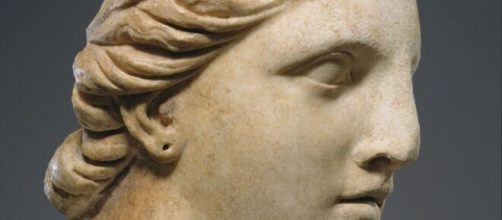Donald Trump’s Florida home wasn’t the only place where government authorities found stolen material.
Last week, the Manhattan District Attorney’s office, wielding three search warrants, retrieved more than two dozen stolen antiquities held by the Metropolitan Museum.
That’s not all that the Met had to give back. Alvin Bragg, representing the DA’s office, told CNN that next week more items are headed back to their owners: 58 objects to Italy and 16 to Egypt.
One of the objects going to Italy is the “Marble Head of Athena,” circa 200 BC, looted from a temple in central Italy.
Reportedly, it had been bought and sold many times before it landed at the Met. The museum has been displaying it for the last 26 years.
Where’s the rest of me?
Given that “Marblehead of Athena” originated in Greece, don’t you wonder how it ended up in a temple in Italy? It’s all the more puzzling because this head once topped a full-length statue of the warrior goddess. Exhibit information says that her statue was a protectress of the city of Athens. In other words, she was no temple statue.
Bragg’s explanation of how Athena ended up in Italy seems to put Italy’s ownership in question. As he said, “It should be no secret to collectors, art museums and auction houses that they may be in possession of pieces from known traffickers that were illegally looted.”
In that case, returning the head of Athena to Italy may not be a case of righting a wrong.
All of this has me questioning whether returning all stolen artworks to their last owners is the right thing to do.
Hear me out
Since robbing a country's art is an old story, and since the booty changed hands almost as often as political power has changed, who’s to say who owns what?
Besides, if every art museum were to return all the art treasures to their original owners, the halls of such treasure houses worldwide would be empty.
The Louvre, for instance, would have to return its numerous Old Masters that Napoleon's armies looted from Italy and neighboring lands.
So, for all the reasons above, should governments be in the business of draining art museums of their stolen works to rectify a crime committed centuries ago?
If, say, “Head of Athena” stayed put in the temple in Italy, how many people would have been able to see it?
The Met’s yearly attendance has been reported as high as seven million. Shouldn’t that be a consideration?
Of course, if it’s ever decided to let museums keep their collections - there would need to be exceptions. I’m thinking of the painting that the Nazis stole from Adele Bloch-Bauer – her portrait by famed Expressionist Gustave Klimt. It was a personal loss, not merely a possession, to her heirs.
At the movies
You may remember the legal battles that Adele Bloch-Bauer’s niece endured to have the painting returned in the 2015 movie “Woman in Gold” starring Dame Helen Mirren as the niece.
But exceptions like that aside, shouldn’t privately held artworks – particularly Old Master works – be in public view.
A painting called “The Beckoning Gallery” by Charles Wilson Peale comes to mind. In it, you see him lifting a curtain from a wall of paintings that was the beginning of the Philadelphia Museum of Art founded in 1785,
Peale’s painting unwittingly illustrates “The Art-Idea” put forth by the American collector James Jackson Jarvis in 1864. The collector said that in order to encourage the “art feeling” in the general public, people need access to museums that show art of all nations.
If governments like ours continue to rectify every claim of every piece of stolen art from every country, it will wipe out museum collections and Jarvis’ “Art-Idea” along with it.


